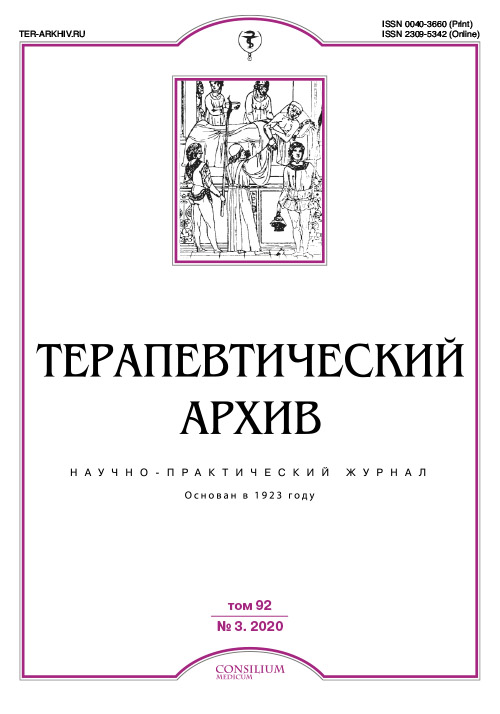Assessment of the respiratory muscles strength at patients with chronic obstructive pulmonary disease with various forms of comorbidity
- 作者: Kurpatov I.G.1, Geltser B.I.1, Kinyaikin M.F.2,3
-
隶属关系:
- Far Eastern Federal University
- Vladivostok State Medical University
- Primorskii Regional Clinical Hospital №1
- 期: 卷 92, 编号 3 (2020)
- 页面: 7-12
- 栏目: Editorial
- URL: https://journal-vniispk.ru/0040-3660/article/view/33885
- DOI: https://doi.org/10.26442/00403660.2020.03.000239
- ID: 33885
如何引用文章
全文:
详细
The respiratory muscles (RM) strength is the main indicator of their functional state. However, RM strength is not used as criteria for chronic obstructive pulmonary disease (COPD) stratification.
Aim. To evaluate the RM power of COPD patients with various variants of comorbidity and to determine the role of comorbidity in the development of respiratory muscle dysfunction.
Materials and methods. RM strength of 64 men with exacerbation of COPD was studied. The severity of comorbidity was assessed by the Charlson index. Depending on the prevalence of comorbidity, patients were divided into 3 groups: cardiovascular, cerebrovascular and metabolic. Maximum inspiratory (MIP) and expiratory (MEP) pressures in the oral cavity, maximum rate of pressure development (MRPD), sniff nasal inspiratory pressure (SNIP), MEP/MIP and SNIP/MIP indexes were determined with MicroRPM device (UK). Measured values of MIP, MEP and SNIP were compared with the proper ones. The most noticeable decrease of RM strength was defined in the group of patients with severe comorbidity.
Results. In case of a mild comorbidity MEP and SNIP values were 68 and 78% of the predicted values and MIP value corresponded to the personified standard. RM strength of patients with COPD depended on the clinical variant of comorbidity. Thus, in the group of patients with cardiovascular variant of comorbidity auxiliary inspiratory muscles strength decreased. In the group of patients with cerebrovascular variant of comorbidity the expiratory muscles dysfunction predominated. In the group of patients with metabolic variant of comorbidity diaphragm dysfunction predominated.
Conclusion. The pathogenetic significance of various factors of COPD comorbidity in the development of RM dysfunction was confirmed by the results of the correlation analysis.
作者简介
I. Kurpatov
Far Eastern Federal University
编辑信件的主要联系方式.
Email: kurpatov-i@mail.ru
ORCID iD: 0000-0002-4031-2979
Postgraduate Student, Department of Clinical Medicine
俄罗斯联邦, VladivostokB. Geltser
Far Eastern Federal University
Email: kurpatov-i@mail.ru
ORCID iD: 0000-0002-9250-557X
чл.-кор. РАН, д.м.н., проф., дир. департамента клинической медицины
俄罗斯联邦, VladivostokM. Kinyaikin
Vladivostok State Medical University; Primorskii Regional Clinical Hospital №1
Email: kurpatov-i@mail.ru
ORCID iD: 0000-0002-5498-9008
к.м.н., доц. Института терапии и инструментальной диагностики; зав. Краевым пульмонологическим центром
俄罗斯联邦, Vladivostok参考
- Srivastava K, Thakur D, Sharma S, Punekar YS. Systematic review of humanistic and economic burden of symptomatic chronic obstructive pulmonary disease. Pharmacoeconomics. 2015;33:467-88. doi: 10.1007/s40273-015-0252-4
- Ehteshami-Afshar S, FitzGerald JM, Doyle-Waters MM, Sadatsafavi M. The global economic burden of asthma and chronic obstructive pulmonary disease. The International Journal of Tuberculosis and Lung Disease. Int Union Against Tuberculosis Lung Dis. 2016;20(1):11-23. doi: 10.5588/ijtld.15.0472
- Shibata Y. Epidemiology of COPD: Why Is the Disease So Poorly Recognized? Chronic Obstructive Pulmonary Disease. Springer Nature. 2016;17-28. doi: 10.1007/978-981-10-0839-9_2
- Global strategy for the diagnosis, management, and prevention of chronic obstructive pulmonary disease. Available at: http://www.goldcopd.org
- Müllerova H, Agusti A, Erqou S, Mapel DW. Cardiovascular Comorbidity in COPD. Chest. Elsevier BV. 2013;144(4):1163-78. doi: 10.1378/chest.12-2847
- Lahousse L, Tiemeier H, Ikram MA, Brusselle GG. Chronic obstructive pulmonary disease and cerebrovascular disease: A comprehensive review. Respiratory Medicine. Elsevier BV. 2015;109(11):1371-80. doi: 10.1016/j.rmed.2015.07.014
- Calancea V, Matcovschi S, Ghicavii N, et al. Peculiarities of cardiac rhythm in stable chronic obstructive pulmonary disease. Clinical Problems COPD. 2017. doi: 10.1183/1393003.congress-2017.pa3645
- Portegies ML, Lahousse L, Joos GF. Chronic Obstructive Pulmonary Disease and the Risk of Stroke. The Rotterdam Study. Am J Respir Crit Care Med. 2016;193(3):251-8. doi: 10.1164/rccm.201505-0962OC
- Kaźmierczak M, Ciebiada M, Pękala-Wojciechowska A, et al. Evaluation of Markers of Inflammation and Oxidative Stress in COPD Patients with or without Cardiovascular Comorbidities. Heart, Lung and Circulation. Elsevier BV. 2015;24(8):817-23. doi: 10.1016/j.hlc.2015.01.019
- Rubinsztajn R, Przybyłowski T, Maskey-Warzęchowska M, et al. Metabolic Syndrome as a Factor Affecting Systemic Inflammation in Patients with Chronic Obstructive Pulmonary Disease. Advances Experimental Med Biol. 2017;55-62. doi: 10.1007/5584_ 2017_28
- Barreiro E, Gea J. Respiratory and Limb Muscle Dysfunction in COPD. COPD: J Chronic Obstructive Pulmonary Dis. 2014;12(4):413-26. doi: 10.3109/15412555.2014.974737
- Kaminska M, Noel F, Petrof BJ. Optimal method for assessment of respiratory muscle strength in neuromuscular disorders using sniff nasal inspiratory pressure (SNIP). PLOS ONE. 2017;12(5):e0177723. doi: 10.1371/journal.pone.0177723
- Рекомендации по ведению больных с метаболическим синдромом. М., 2013 [Management of patients with metabolic syndrome guidance. Мoscow, 2013 (In Russ.)].
- Rodrigues A, Silva M, Berton D, et al. Maximal inspiratory pressure: does the choice of reference values matter? Clin Physiol, Exercise Functional Imaging. 2016;152(1):32-9. doi: 10.1183/ 13993003.congress-2016.pa2251
- Пульмонология. Национальное руководство. Российское респираторное общество, Ассоциация медицинских обществ по качеству. Под ред. А.Г. Чучалина. М.: ГЭОТАР-Медиа, 2009 [Pulmonology. National guidance. Russian Respiratory Society, Association of Medical Societies for Quality. Ed. A.G. Chuchalin. Мoscow, 2009 (In Russ.)].
- Gea J, Agustí A, Roca J. Pathophysiology of muscle dysfunction in COPD. J Appl Physiol. 2013;114(9):1222-34. doi: 10.1152/japplphysiol.00981.2012
- Bar B, Hemphill J. Charlson Comorbidity Index Adjustment in Intracerebral Hemorrhage. Stroke. 2011;42(10):2944-6. doi: 10.1161/strokeaha.111.617639
- Charususin N, Dacha S, Gosselink R, et al. Respiratory muscle function and exercise limitation in patients with chronic obstructive pulmonary disease: a review. Expert Rev Respiratory Med. 2017;12(1):67-79. doi: 10.1080/17476348.2018.1398084
补充文件







